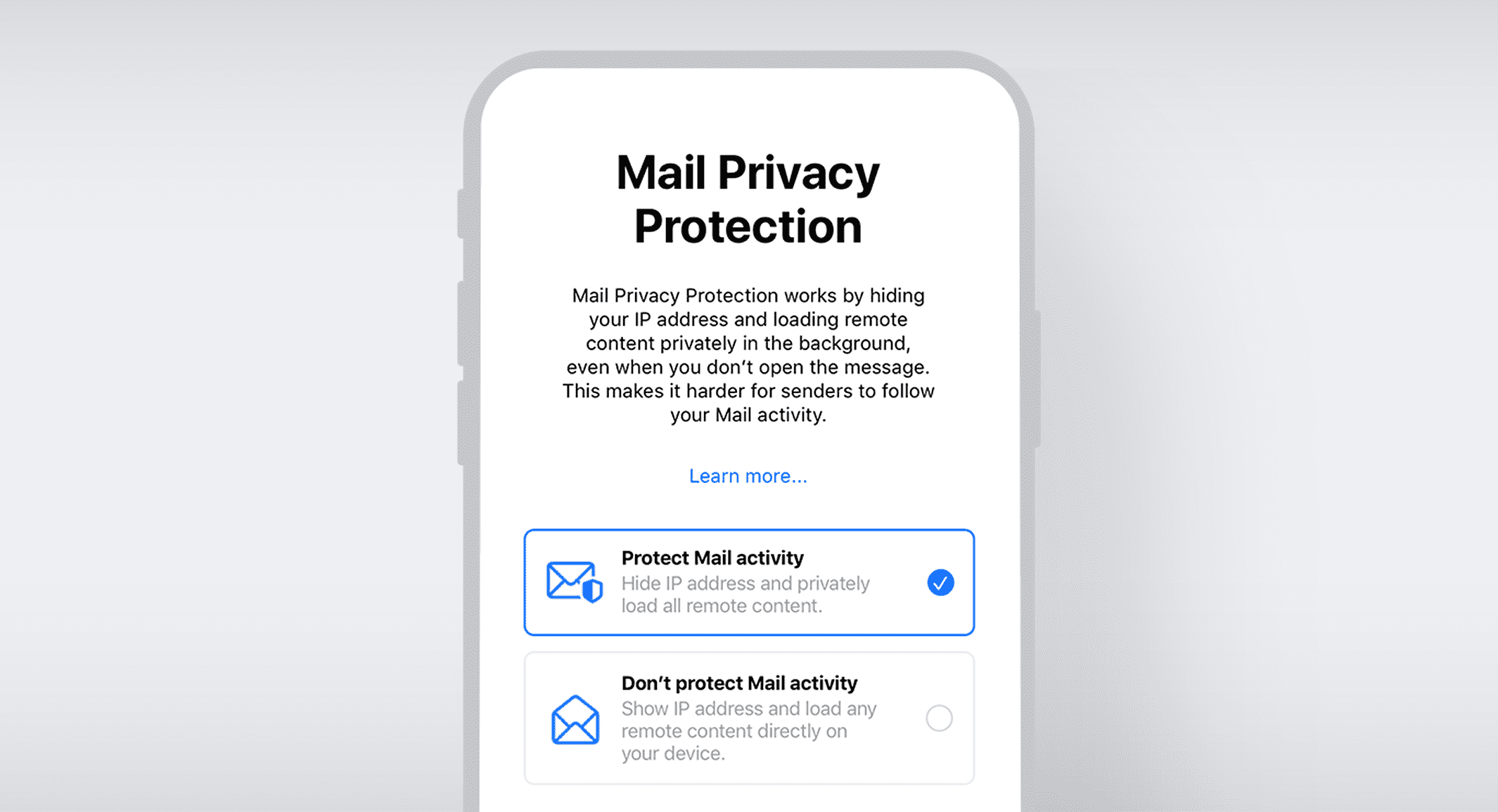How Apple's iOS 15 Mail Privacy Updates Affect Email Marketing Optimization
Changes Coming with the iOS 15 Update
In the fall of 2021, Apple will be rolling out iOS 15, which comes with new data and privacy updates designed to help users control and monitor their app’s use of their personal data.
Following the iOS 14 updates and the implementation of App Tracking Transparency (ATT), which forced advertisers to shift their event tracking strategies, Apple continues to implement changes that will require marketers to make some updates to their marketing efforts. In the case of iOS 15, these updates will predominantly affect email marketing strategies.
Apple Mail Updates & Impacts on Email Marketing
Apple’s iOS 15 update has three major components that will affect email marketing—the ability to turn off open rate tracking, block your IP address, and hide your email address.
Apple’s Mail Privacy Protection
Following Apple’s iOS 15 announcement, some marketers have jumped to the conclusion that “email is dead” and that email open rate metrics will no longer be valuable to email marketers. The good news is, email marketing is not dead. Will marketers have to pivot their email marketing strategies? Yes, but in no way will email marketing cease to exist.
The reality is, there is impending unreliability of the open rate results from Apple’s implementation of Mail Privacy Protection, which will be a feature on Apple’s Mail app across all Apple devices. When the update comes to fruition, Apple device users will have the choice to opt-in to Mail Privacy Protection—it will not take effect automatically. That being said, marketers can expect that most users will opt-in, as users likely will not decline an offer to be protected against data tracking. In fact, following the rollout of iOS 14, 96% of Apple users opted out of data tracking; one can assume that a similar trend will follow once iOS 15 is released.
Mail Privacy Protection feature
According to Apple, Mail Privacy Protection “stops senders from using invisible pixels to collect information about the user.” Put simply, the update allows Apple Mail users to protect themselves from senders knowing exactly when they opened an email. Users will also have the ability to hide their IP addresses from trackers for increased privacy protection. What this means is that web trackers can no longer leverage a user’s IP address to bridge their activity across websites and use their data to create a profile about them.
Mail Privacy Protection: How It Works
When an Apple Mail user first opens the Apple Mail app, they will be prompted to select either “Protect Mail activity” or “Don’t protect Mail activity.” When a user selects “Protect Mail activity,” Apple will send all emails through a proxy server where images and message content are pre-loaded before delivering the email to a user’s inbox. As a result, email marketers will see artificially high open rates since all emails in Apple Mail will be opened, even if the readers themselves do not open the emails.
Additional iOS 15 Updates in Favour of User Privacy
Along with Mail Privacy Protection, the iOS software update for iPhone, iPad, Apple Watch, and Mac will offer even more ways for Apple customers to limit or prevent data-sharing. These new privacy features include Hide My Email and Private Relay, all part of iCloud+, Apple’s iCloud paid subscription service.
Hide My Email feature
Apple’s New Hide My Email Feature
Hide My Email is an updated version of an existing Apple feature that allows users to create a unique, random email address. The email address is created when Apple users create a website account in Safari. Users will see a prompt offering to Hide My Email, which generates a random email address. Users can then use it when they wish to keep their personal email private. The unique email address is forwarded to their personal inboxes at any time, at the user’s discretion. Hide My Email also enables users to create and delete as many addresses as they want, helping to give users control over who can contact them.
For email marketers, it may be difficult to understand engagement metrics for those who have enabled the Hide My Email feature; all engagement data will be for a proxy email rather than a user’s personal email address. While the feature prevents web tracking of a consumer across several different platforms, it does allow for one-to-one communication between brands and customers who opt-in to receive marketing emails.
Private Relay & the Impact on Data Tracking in Email Marketing
Apple will also be implementing Private Relay, which comes as an update to iCloud+. Private Relay is an internet privacy service that encrypts web browsing data and assigns an anonymous IP address to a user, making it significantly more difficult for websites to track users’ browsing activities on Safari.
Users’ activity is sent through two separate internet relays. The first one assigns the user an anonymous IP address that maps to their region but not their specific location. The second relay decrypts the web address they want to visit and forwards them to their destination. Separating users’ information from their activity, protects a user’s privacy, as there is no data pertaining to who the user is, and which site they visit.
While this update is more closely related to third-party tracking, there is an implication for email marketing efforts. This update will make it significantly more difficult for marketers to personalize their email marketing campaigns by sending emails based on a recipient’s local time zone or location. As recommended by Northern, email campaigns should be deployed based on recipients’ local timezone. If a user’s IP address is blocked, this prevents email marketers from further personalizing and optimizing the send-time of their email campaigns, as it impacts the accuracy of recipients’ local time zones and locations.
Implications for Email Marketers
Email personalization strategies are anticipated to become a challenge for email marketers to implement. Not only do users expect to receive highly personalized emails and marketing messages, but they also want to receive them. Email marketing is a unique marketing channel in the sense that users have to opt-in to receive marketing emails, implying that email recipients want to hear from the brands and companies they provide their email addresses to. With the iOS 15 privacy updates, it will be increasingly difficult for companies to send valuable information and content to users that want to receive it.
Moving forward, email marketers will have to adjust their interpretations of deliverability metrics and how the success of an email campaign or workflow is measured. To start, open rates will no longer indicate email list health. While Apple will know which users will engage with certain emails, email marketers will no longer be privy to this information. It will be essential for email marketers to analyze varying engagement indicators to determine overall account health.
How Email Marketers Can Prepare for iOS 15
Email marketers will have to understand their current audience segments—namely, what percentage of their audience uses Apple Mail. According to data from Email Client Market Share, over 46% of combined email opens were from Apple devices in 2020. This means that there is a strong chance that a large portion of many brands’ email subscribers are Apple Mail users and an even greater chance these users will opt-in to Mail Privacy Protection.
Since so much emphasis has been placed on the power of open rates to define email list health, deploying re-engagement series, and determining send-time optimization, to name a few, email marketers will need to rethink what qualifies an engaged subscriber, how to re-engage subscribers, and how to effectively segment email subscribers. Rather than focusing on open rates, email experts will need to pivot and look closer at metrics such as click data, active on-site, and placed order metrics.
Most importantly, email marketers will need to look to new email marketing channels to get their message across to those who want to hear it. Channels like SMS and push notifications are integral for expanding your reach and nurturing relationships with your engaged audience.
Users are still required to opt-in to receive SMS notifications from the brands they love. These short-form messages are a great way to keep your audience up-to-date on the latest from your brand or company, while leveraging highly personalized messaging strategies that ultimately result in an average ROI of 24X. According to Klaviyo, 99% of all texts are read, and 90% of messages are read within 3 minutes of deliverability. Additionally, SMS is preferred over email by 63% of customers, who are willing to change their brand loyalty to those that communicate via text.
Northern recognizes that the rollout of iOS 15 will have an impact on email marketing efforts. To prepare for the update, our team will work with you to determine the best solutions that generate the strongest results for your brand or organization. If you are looking for ways to prepare for the iOS 15 update, contact Northern today.
For more information, check out the resources below:
https://www.omnisend.com/blog/update-marketing-automation-ios15/
Stay informed, sign up for our newsletter.




